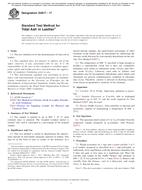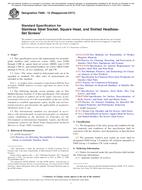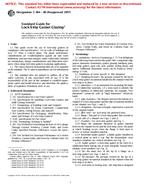1.1 This test method covers the determination of total oxygen demand in the range from 100 to 100 000 mg/L, in water and wastewater including brackish waters and brines (see 6.5). Larger concentrations, or samples with high suspended solids, or both, may be determined by suitable dilution of the sample.
1.1.1 Since the analysis is based on the change in oxygen reading of the carrier gas compared to that when a sample is introduced (see 4.1), the measurement range is a function of the amount of oxygen in the carrier gas. The higher the desired concentration range, the more oxygen required in the carrier gas. Under recommended conditions, the carrier gas concentration should be between two to four times the maximum desired oxygen demand.
1.1.2 The lower measurement range is limited by the stability of the baseline oxygen detector output. This signal is a function of the permeation system temperature, carrier gas flow rate, oxygen detector temperature, and reference sensor voltage. Combined, these variables limit the minimum recommended range to 2 to 100 mg/L.
1.1.3 The upper measurement range is limited by the maximum oxygen concentration in the carrier gas (100%). With the recommended conditions of carrier gas concentration being two to four times the maximum oxygen demand, this limits the maximum possible oxygen demand to between 250 000 to 500 000 mg/L. However, as a practical application to water analysis, this test method will consider a maximum range of 100 000 mg/L.
1.2 This test method is applicable to all oxygen-demanding substances under the conditions of the test contained in the sample that can be injected into the reaction zone. The injector opening limits the maximum size of particles that can be injected. If oxygen-demanding substances that are water-insoluble liquids or solids are present, a preliminary treatment may be desired. These pretreatment methods are described in Annex A2.
1.3 This test method is particularly useful for measuring oxygen demand in certain industrial effluents and process streams. Its application for monitoring secondary sewage effluents is not established. Its use for the monitoring of natural waters is greatly limited by the interferences defined in Section 6.
1.4 In addition to laboratory analysis, this test method is applicable to on-stream monitoring. Sample conditioning techniques for solids pretreatment applications are noted in Annex A2.
1.5 The values stated in SI units are to be regarded as the standard.
1.6 This standard does not purport to address all of the safety concerns, if any, associated with its use. It is the responsibility of the user of this standard to establish appropriate safety and health practices and determine the applicability of regulatory limitations prior to use.
Product Details
- Published:
- 01/01/2003
- Number of Pages:
- 7
- File Size:
- 1 file , 84 KB


